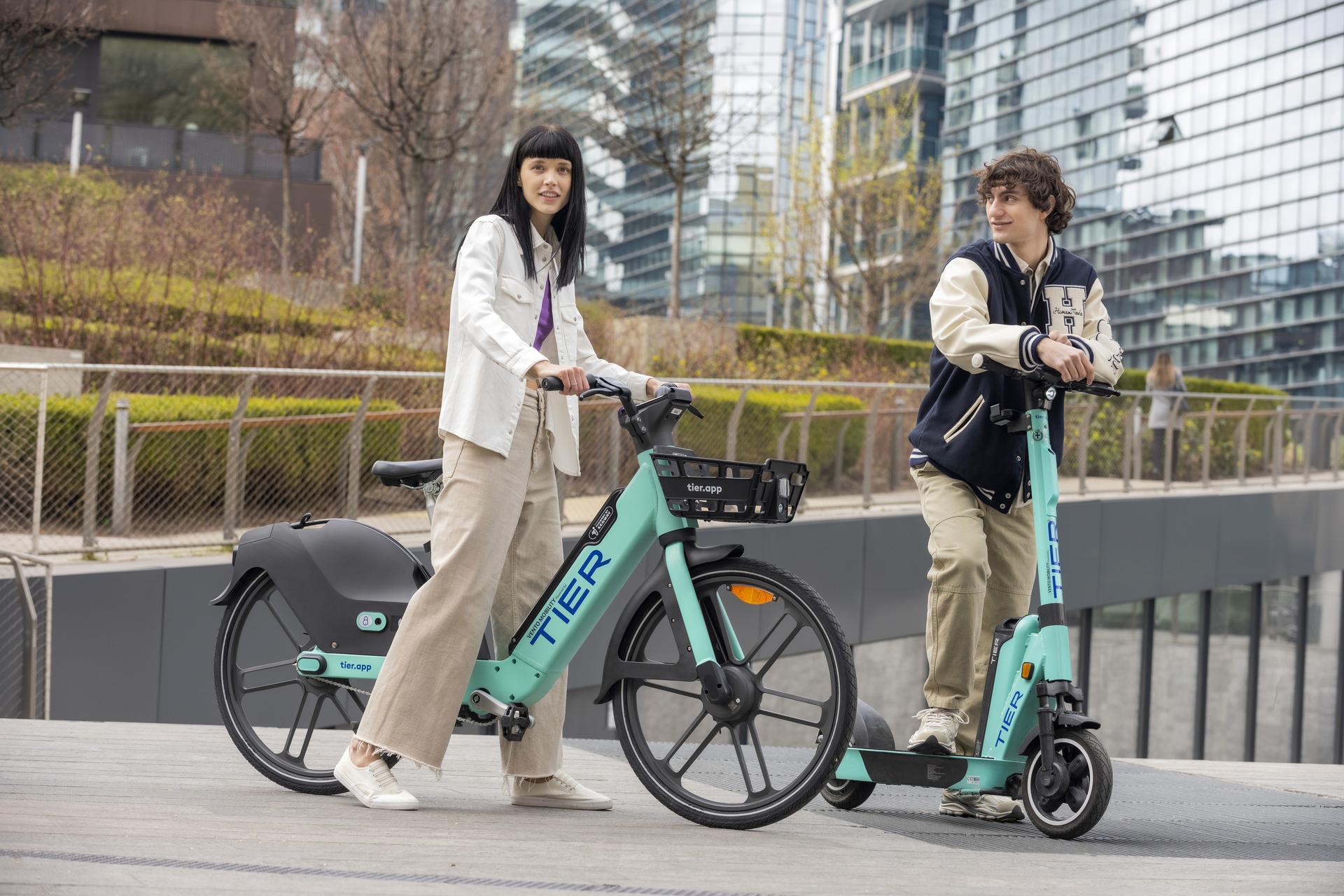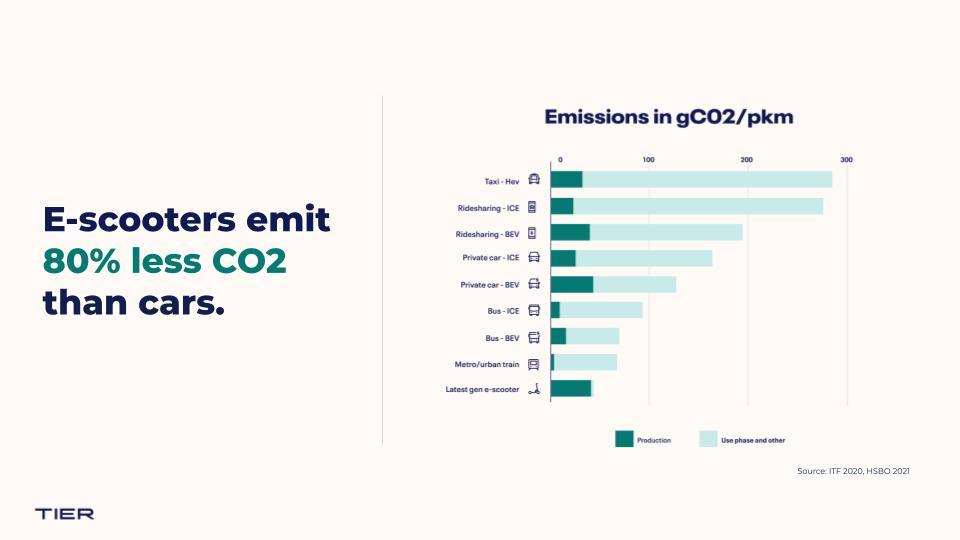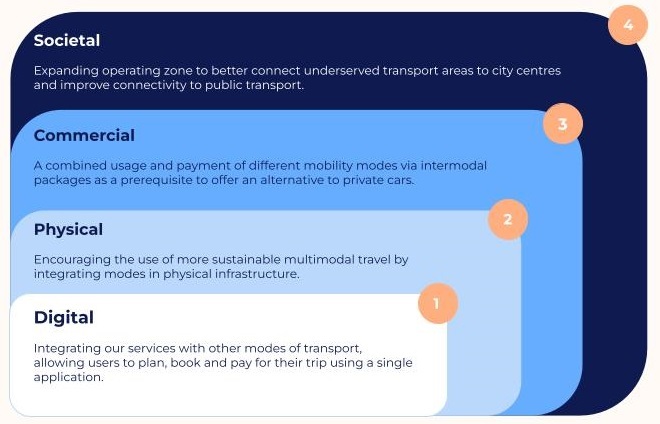Sustainability
Cities
How can micro-mobility best contribute to the sustainable mobility transition?
June 24, 2022
By Ailin Huang, Head of Sustainability and Pauline Aymonier, Head of Public Policy - Smart & Sustainable City

Today, private vehicles emit three quarters of CO2 from urban passenger transport while only representing 50% of the km travelled. And while we expect the current regulatory framework to improve this, emissions are still expected to increase 16% by 2050. Implementing the right policies, however, has the potential to instead cut 80% of urban mobility’s carbon footprint by 2050 and put us in line with the emission reduction trajectory of the Paris Agreement (ITF 2020).
By 2050 we expect that growing urbanisation will increase demand for sustainable transport around the world by a factor of 2.6. Increasing the supply and variety of more sustainable mobility services will be key not only to green our cities, but also to mitigate the dangerous effects of climate change. According to the ITF (2020), in order to achieve a sustainable and resilient transport transport mix, active travel, micro-mobility and shared mobility need to account for close to 60% of the world’s global transport activity by 2050. While the world is taking positive steps towards sustainable mobility transition, there is still a significant gap in achieving this aim.
How does micro-mobility contribute to the sustainable mobility transition?
By replacing cars with a multi-modal offering
Studies show that about 40% of car rides are replaceable, in the sense that people can imagine replacing them. Different micro-mobility modes, including electric scooters, bikes and mopeds, can serve different distances to replace car usage. TIER Mobility, as a multimodal operator, offers a range of vehicles that can serve different distances and use cases. In our latest user research we have found that e-scooters are mostly used for short distances with an average of 2.5km, whereas e-bikes are used for mid-range distances, clearly indicating the need for a variety of sustainable choices to meet urban citizens’ needs.
Now the premise of this is that micro-mobility modes are less carbon and energy intensive than cars. And from the perspective of our vehicle’s lifecycle environmental performance (gCO2/pkm), our latest generation e-scooter creates less than a third of the emissions of a private car. The emission savings are even greater when compared with taxis (270g CO2/pkm) and ridesharing (220g CO2/pkm). From this perspective, the latest generation of e-scooters are on par with public transport options, which make them an excellent choice for first and last mile connectivity.

Overall this means that, to date, through our services, we have avoided 45 million car kms from being driven, and have avoided 7.5 million kg of CO2 emissions.
By continuously improving environmental performance
As a micro-mobility provider, we can further contribute to the sustainable mobility transition by continuously improving our own environmental performance and driving higher sustainability standards across our industry.
In just three years, we have increased the lifespan of our e-scooters from six months to five years, we shifted to swappable batteries to significantly reduce the distance travelled for our operations, and are transitioning to electric servicing fleets (eVans and eCargo bikes) and supplying green energy in our warehouses.
We are contributing to the greening of cities by continuously improving our environmental performance and setting ambitious emission reduction goals that contribute to cities climate action plans. All these improvements mean that in less than three years we have reduced the CO2 emissions of our e-scooters by over 60%.
By complementing the public transport system
Micro-mobility also has a role to play in making public transport more connected and resilient by acting as a convenient and flexible linkage. We see ourselves as an extended arm of public transport by complementing and expanding existing networks’ reach, as the backbone of our transportation systems.
A recent analysis we conducted showed that, on average, one out of four users use our micro-mobility solutions for the first and last mile, and as many as 44% of users occasionally combine travel with our vehicles and other forms of transport. This data clearly indicates the potential of micro-mobility to make public transport more resilient and connected in the long-run.
With the right incentives, partnerships and multimodal infrastructure in place, micro-mobility can act as a funnel to get people back onto public transport, especially in the context of a post COVID world.
What role should public private partnerships play in driving this transition?
But the impact of all these actions will only really matter if implemented at scale. TIER’s mission to Change Mobility for Good is one that nobody can achieve alone: public private partnership and collaboration is needed at various institutional levels, to drive the sustainable mobility transition collectively with Cities, Public Transport Authorities, Academia and International policy. How can this be implemented in practice?
Understanding cities’ mobility needs and habits through data
Through its IoT integrated vehicles, TIER is able to collect data on the usage of its services and to better understand the mobility habits and needs in a city. We gain insights into the blockers and amplifiers of modal shift, the connection between usage and infrastructure, public transport connectivity, and changing mobility demand over time.
Mobility data has the potential to shed light on the mobility challenges we and our cities are up against to tackle them more efficiently, through data-based policy-making and urban planning. It presents a powerful opportunity to understand and manage our cities better, and more sustainably, i.e. for space management, infrastructure planning, multimodal integration and encouraging modal shift. TIER is convinced of the value that mobility data can bring to public stakeholders to inform their local sustainable urban mobility plans, and already shares its insights with many of the 500 cities it operates in.
But the full potential of our mobility data is not yet tapped into. To date, cities have tended to use this data primarily for monitoring purposes, with only a handful partnering directly with us to unlock deep insights. Improved collaboration on the topic, notably by creating a framework to map out how mobility data can support specific policy use cases and sustainability objectives for cities, will help cities remain competitive and able to meet the needs of their citizens.
Rethinking urban transport holistically across shared and public modes
Collaboration with other modes of transport including public transport is a prerequisite to ensuring that micro-mobility efficiently integrates into existing networks. With 50+ active partnership with Public Transport organisations and 40+ Mobility-as-a-Service (MaaS) integrations in 10 countries, we see these collaborations as an opportunity to rethink urban transport holistically, notably by anchoring the concept of intermodality further in our daily commuting habits.
To achieve this, integration with other transport modes and public transport needs to happen at various levels, namely: Digital, Physical, Commercial and Societal. Only by integrating on these levels can we fully unleash the potential social and environmental benefits that more intermodal transportation systems can generate.

TIER has piloted integrations on these different levels through various pilots with Public Transport authorities, cities and MaaS platforms. In Berlin, TIER works very closely with Jelbi to set-up and integrate in their 15 multimodal parking hubs in proximity to key transit hubs. In Finland and Switzerland, we have piloted together with local public transport operators HSL and SBB bundle packages integrating public transport tickets and TIER subscriptions into a single commercial offer. In Hamburg, we have expanded our business area to outer districts of the city, in partnership with Hamburger Hochbahn, to better serve and connect areas that are not easily accessible through public transport.
Through these pilot projects, we have gathered great insights into users’ mobility choices and appetite for a multimodal transport future, such as the fact that integrated tickets with public transport and micro-mobility increases the value of users' Public Transport subscriptions. This sets best practice models for future public private collaboration to ensure that various transport modes are collectively transitioning towards a greener future.
Measuring the social and environmental impacts of the micro-mobility industry
TIER, and the micro-mobility industry more generally, are very young. There’s a lot that we still need to research, understand and test to fully assess the impact of our services on cities and citizens. This includes exploring how far micro-mobility can go in solving our cities’ challenges. To answer this, close collaboration is needed with academia, to test our hypotheses of how micro-mobility can Change Mobility for Good and contribute to creating more planet- and people-centric cities.
Earlier this year, TIER partnered with the Paris School of Economics (PSE), a leading Economics university in Europe, to understand the underlying dynamics making cities more sustainable, resilient and connected. With this partnership, we intend to build learnings into the social and environmental benefits of micro-mobility, as well as best practices to efficiently regulate the industry, in a way that can be replicated globally.
Recently, PSE researchers have been working on understanding the impact of mandatory parking regulations on the accessibility, adoption and usage level of shared mobility, as a key tool to green our urban transportation systems. Such insights will bring key learnings for our cities to best regulate micro-mobility in a way that allows for the materialisation of its benefits.
Regulating the sustainable mobility transition with an intermodal lense
Another key layer of public private collaboration revolves around setting the right regulatory framework to encourage and accelerate the sustainable mobility transition, notably through intermodality.
As it stands, our transportation system is regulated in a siloed and mode-specific manner. This is primarily due to the way our transport governance has historically been set-up, with separate governing entities regulating different modes of transport. Because of this, micro-mobility is primarily being regulated as a standalone mode, rather than how it fits into our broader urban mobility systems.
This has often resulted in the design of uneven regulations that still tend to favour private cars. Looking at this from the perspective of fees, it is costlier for the micro-mobility industry to operate in the public right of way than it is for cars. From a space usage perspective, our current cityscapes make it easier for citizens to drive a car than to use other-greener-modes of transport.
Working with governments, the European and International policy community will be key to define and regulate the sustainable and intermodal transport future we envision for our cities. TIER is already a board member of the International Transport Forum and was recently selected to be part of the European Commission’s expert group on MaaS, to advise on the design of a European policy framework that encourages its development. We are also working with the World Economic Forum to shape the future of mobility.
Holding conversations around micro-mobility’s evolving role in the sustainable mobility transition is key to understanding the important role it can play. The impact of our and the industry’s action will only really make a change if implemented together with our public, private and academic partners, in a collective effort to Change Mobility for Good. The inspiration for this blog post is a case in point, benefiting from discussions with talented students at TU Berlin.
TIER Mobility has a number of partnerships with leading universities to ensure sustainable mobility transition. This blog post was adapted from a guest lecture given by Pauline Aymonier and Ailin Huang to students of TU Berlin’s MBA on Sustainable Mobility Management.